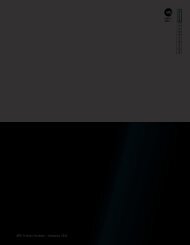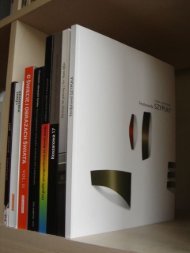akademia 2007+
o sztuce - ASP Katowice
o sztuce - ASP Katowice
- No tags were found...
You also want an ePaper? Increase the reach of your titles
YUMPU automatically turns print PDFs into web optimized ePapers that Google loves.
against academicism, where the author presents current models of artistic<br />
education as a consequence of epistemological changes connecting art<br />
and teaching in the wider frame of social context in a triadic form: from<br />
talent-métier-imitation in the classical understanding, through creativitymedium-innovation<br />
in Bauhaus, to attitude-practice-deconstruction in the<br />
1980s. As a result, art emerges as one of the signification practices, and<br />
one highly mediated. On the dangers that spring from the victory of functionalism,<br />
leading everywhere to the total unification of reality comments<br />
Zbigniew Gorlak in his essay Legoism – the uniform of civilized world. He<br />
refers to the omnipresent tendency for design standardization under the<br />
guise of economy and minimum effort. Unfortunately this directive employed<br />
without consideration leads to a world that is everywhere the same,<br />
one-dimensional. It is a civilization of Legoism, a world deprived of diversity<br />
at its own request. Antoni Porczak in Classified writes on the hidden<br />
mechanisms that guide all decisions and choices, including those made at<br />
the Academy, showing that those mechanisms are not subject to any control,<br />
exactly due to their discrete nature, but the results of their functioning<br />
have a very tangible character. In the practice of the Academy these<br />
are the bureaucratic norms, also in the field of transmitting attitudes towards<br />
art and its understanding as a distinctive and peculiar practice. In<br />
turn, the two texts that follow, Cultural capital as a field of communication<br />
and artistic creation by Adam Bartoszek and The cultural capital of students<br />
at the AFA in Katowice by Krzysztof Stadler, focus on a different sort<br />
of problem than the previous texts. They are classic sociological analyses,<br />
the first showing the analytical character of the notion of social and cultural<br />
capital, above all in their classic application to the analysis of artistic<br />
community, with respect to the Academy of Fine Arts, and the second by<br />
employing this theoretical frame tries to formulate foundations for empirical<br />
research in this field in terms of both quantity and quality according<br />
to the FGI standards (such research was in fact conducted at the AFA<br />
in Katowice in 2008).<br />
Finally, part four, On the problems of art, is a collection of comments<br />
on general topics, but with relation to concrete artistic manifestations<br />
and achievements. It opens with a text by Beata Wąsowska I think<br />
therefore I create. A redefinition of art terms, with an attempt at the seemingly<br />
hopeless task of defining a work of art today. This interesting endeavour,<br />
without hesitation revealing its methodological, legal, epistemological,<br />
anthropological contexts and difficulties, and in the end its proper<br />
grounding in facts leads to the formulation of the author’s own proposed<br />
definition. Maria Korusiewicz, starting with the hermeneutic tradition<br />
and post-Heideggerian anthropology, with the use of metaphor poetic in<br />
origin, attempts a similar task: delineating the actual boundaries of art,<br />
a work of art, being an artist. In his analysis, an artist is the one who conquers,<br />
shares, fights the Shadow (in the Jungian sense), and as a consequence<br />
can receive the gift of meaning. Next, the problem of copy and original<br />
resurfaces again in the text by Anna Manicka «The best days are those<br />
when I make ten thousand dollars for a print before breakfast». The graphic<br />
art of Salvador Dali in the context of the noble art of reproduction, analysing<br />
with detailed precision the delineated problem, which has never caused<br />
so much controversy as today and which reveals its intentional core. The<br />
subsequent text by Tomasz Gryglewicz, The matrix of violence, is a voice<br />
of an art historian, who from his perspective discusses two important artistic<br />
expressions (Ksawery Kaliski and Andrzej Bednarczyk) at the 26 th<br />
International Biennial of Graphic Art in Ljubljana. Aside from the discussion<br />
there is also a significant theoretical conception of graphic art –<br />
matrix understood as the matrix of re-pression with all its consequences.<br />
The question posed in the title of the essay by Wiesław Gdowicz Is there<br />
sign without meaning? directs the attention to the singularity of the sign’s<br />
existence, namely its existential dependence and its irremovably mediated<br />
cognitive nature. The author uses Gadamer’s hermeneutics on an example<br />
from the Bible (the story of Samuel’s calling from the First Book<br />
of Samuel) and reaches the conclusion that there can be no sign without<br />
meaning. Somewhat different contexts are revealed in the text Tradition<br />
and memory as the basis of creative thinking by Janusz Karbowniczek. It is<br />
another confrontation with the problem of the relation between tradition<br />
and modernity, in this case with relation to artistic creation. Most likely<br />
this problem can never be considered as solved, and it is likely that each<br />
generation will try to define it anew. According to the author, dismissive<br />
summary<br />
304 305






